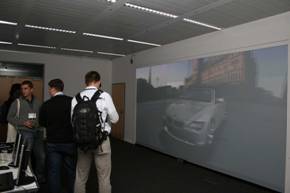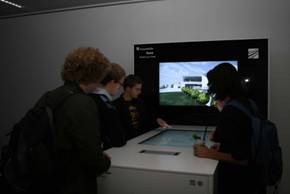|
DAGM is the German section of the IAPR. Every year a conference is held in Germany (or one of the surrounding countries). This year, DAGM took place in Darmstadt. The main conference was preceded by a day at Fraunhofer IGD (see “Global Pattern Recognition, Fraunhofer IGD”, IAPR Newsletter October 2009 [html] [pdf]) with a workshop on “Pattern Recognition for IT Security”, organized by Stefan Katzenbeisser (Darmstadt), Jana Dittmann (Magdeburg) and Claus Vielhauer (Brandenburg), as well as four tutorials given by renowned experts: · Sparse Linear Models: Reconstruction and Approximate Bayesian Inference – by Matthias Seeger (MPI & University of Saarbrücken, Germany) · Computer Vision on GPUs – by Jan-Michael Frahm (UNC, USA) and P.J. Narayanan (IIIT Hyderabad, India) · Color in Image and Video Processing – by Joost van de Weijer (CVC Barcelona, Spain) · MAP Inference in Discrete Models – by Carsten Rother (Microsoft Research Cambridge, UK) This warming-up day was attended by over 80 participants, enjoying the lectures during the day, and the cocktails during the welcome reception that was held afterward. During the reception the participants had the opportunity to attend a demo program, including a huge high resolution video wall, a multi-touch table, integrated augmented reality graphics with a cultural heritage touch on a digital camera, and a 3D face capturing device. The main conference attracted 200 participants and was held at the Darmstadtium, a new conference center in the center of the city, named after the chemical element Ds that was created / discovered in Darmstadt in 1994. Traditionally, the conference starts off with the Olympus prize ceremony. This prize is awarded by a scientific committee of established researchers to a creative young researcher with excellent achievements in pattern recognition and computer vision. This year, the prize was awarded to Stefan Roth. Cited the jury: “He has made outstanding contributions to computer vision, particularly to probabilistic approaches at the interface to machine learning“. For instance, he developed the Fields of Experts framework, a high-order Markov random field with spatially-extended neighborhood interactions which can be automatically learned from training data.[1] This expressive prior has not only been shown to lead to robust image restoration algorithms, e.g., for inpainting, scratch removal and noise compensation, but has also inspired new high-order random fields models for images and scenes. Moreover, he made a variety of contributions to the area of optical flow, i.e., he characterized the spatial statistics of optical flow, he reconstructed specular surfaces from specular flow and, last but not least, he designed, with collaborators the Middlebury optical flow benchmark, a de-facto standard benchmark in this area. [2] The technical program covered all aspects of pattern recognition ranging from 3D reconstruction to object recognition and medical applications. The call for papers resulted in 134 submissions from institutions in 21 countries. Each paper underwent a rigorous reviewing process based on which the program committee selected a total of 57 papers, corresponding to an acceptance rate of below 45%. Out of all accepted papers, 24 were chosen for oral and 33 for poster presentation. In addition to the presentations from the technical program, there were also three internationally renowned invited speakers at the conference: Richard Szeliski (Microsoft Research Redmond), Yair Weiss (The Hebrew University of Jerusalem), and Andrew Zisserman (University of Oxford) Szeliski spoke on “Weaving the World's Photos into a 3D Web”. The explosion of imagery available on the Internet has opened up a host of new applications in computer vision, image-based modeling, and image-based rendering. It is now possible to automatically reconstruct 3D models of heavily photographed scenes and objects, such as tourist locations, and to recognize these from novel images such as cell phone queries. Szeliski surveyed some of the work in this field, starting with the Photo Tourism image-based modeling and navigation system and then discussed the complexity issues (and solutions) engendered by the huge scale of these datasets. He also discussed work in interactive and automated 3D modeling with a particular emphasis on architectural reconstruction and location recognition in urban environments. Weiss’ talk was entitled “Learning and Inference in Low-Level Vision”. Low level vision addresses the issues of labeling and organizing image pixels according to scene related properties, such as motion, contrast, depth and reflectance. He described attempts to understand low-level vision in humans and machines as optimal inference given the statistics of the world. In particular, he showed how message passing algorithms allow one to solve real-world instances of NP-hard problems and to efficiently learn energy functions despite an exponential number of constraints. Finally, Zisserman talked about “Human Focussed Video Analysis”. Determining the pose and actions of humans is one of the central problems of image and video analysis. The visual problem is challenging because humans are articulated animals, wear loose and varying clothing, self-occlude themselves, and stand against difficult and confusing backgrounds. Nevertheless, the area has seen great progress over the last decade due to advances in modeling, learning, and in the efficiency of algorithms. He described approaches for recognizing human actions and inter-actions, and for determining 2D upper body pose. Examples included various TV videos and feature films, and applications demonstrated learning the gestures of sign language and pose based video retrieval. Due to its success last year at DAGM 2009 in Jena, again a Young Researchers’ Forum was organized to promote scientific interaction between excellent young researchers and our community. This year the contributions of six students were accepted, who presented their Bachelor or Master thesis work during the conference and interacted with the community. The (excellent) conference dinner was held at the Orangerie in Darmstadt, a historic building built in 1720 in a scenic park. During the dinner, Prof Hans Burkhardt, IAPR Fellow, from the University of Freiburg was appointed as honorable member of the DAGM for his numerous activities in pattern recognition and contributions to the society. He has been active as a DAGM board member, e.g. taking the initiative for reforming the DAGM structure and introducing English as the conference language. He has been promoting ICPR attendance in the German society, and is active within the IAPR, for instance in the K.S. Fu prize committee. Two years before the often cited Geman & Geman paper on the Bayesian paradigm using Markov Random Fields for the analysis of images, he introduced Markov processes for image restoration. [3] As organizers, we could say much more, for instance that we found it a great successful conference and that we spend much more time on it than we thought! Something that we want to emphasize is our sincere thanks to all local organizers and student volunteers who helped plan and run DAGM 2010 in Darmstadt. We would also like to sincerely thank all our sponsors for their significant financial support, which helped to keep the registration fees as low as possible, especially those of the student attendees. We were happy to host the 32nd Annual Symposium of the German Association for Pattern Recognition in Darmstadt and look forward to DAGM 2011 in Frankfurt! |
|
Non-IAPR Workshop Report:DAGM2010 |
|
Report prepared by Arjan Kuijper |



|
Footnotes: [1] Stefan Roth and Michael J. Black: Fields of experts. International Journal of Computer Vision (IJCV), 82(2):205-229, April 2009. [2] Simon Baker, Daniel Scharstein, J.P. Lewis, Stefan Roth, Michael J. Black, and Richard Szeliski. A database and evaluation methodology for optical flow. International Journal of Computer Vision (IJCV), 2010. To appear. An extension of their ICCV 2007 paper. [3] “Maximum-A-Posteriori Restoration of Images - An Application of the Viterbi Algorithm to Two-Dimensional Filtering”, ICPR 1982 in Munich. |
|
Proceedings of the conference have been published by Springer in the series Lecture Notes in Computer Science (Volume 6376)
Click on the image to go to the publisher’s web site for this volume. |
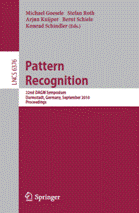
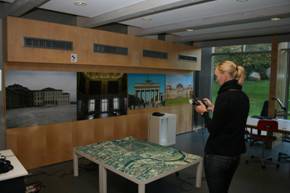
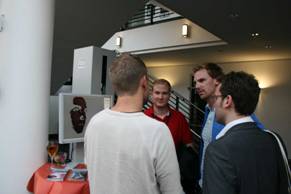
|
Demo program during the welcome reception. |

